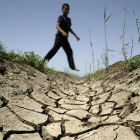21 August 2012 | EN

The 2012 drought has already had a severe impact on South Asian agriculture
Flickr/ Hossam el-Hamalawy
[ISLAMABAD/COLOMBO] The lack of rains in large, monsoon-dependent, agricultural areas of South Asia has compounded concerns expressed in a recent report about an impendingglobal water crisis and its detrimental impact onagriculture.
Poor monsoon rains have diminished the wateravailable for agriculture and groundwater reservoir replenishment in South Asia, as well as making it difficult for farmers to know when to plant crops, scientists in the region have toldSciDev.Net.
These fears coincide with a paper in Naturepublished this month (8 August), which warns that "humans are overexploiting groundwater in many large aquifers that are critical to agriculture, especially in Asia and North America". It reports that 1.7 billion people live in areas where groundwater resources are threatened as a result.
Poor monsoon rains and droughts in India, Pakistan and Sri Lanka have dimmed the prospects of rainwater refilling drained aquifers in the region, experts have said.
"Abnormal and scattered rainy seasons will keep the dams below standard level, affect river flow, keep the canals dry and adversely impact groundwater recharging," Khalid Mohtadullah, senior adviser to the Global Water Partnership in Stockholm, Sweden, told SciDev.Net.
This is likely to affect energy generation, irrigation and groundwater tables, he said.
On 2 August, around halfway through the 2012 monsoon season, India declared a drought, with the Indian Meteorological Department (IMD) reporting that rainfall across India for the second half of the monsoon season — August to September — was likely to be below normal.
There are also fears of El Niñoemerging in the equatorial Pacific, which, the IMD says, is "likely to have an adverse impact on rainfall" in India during this period — concerns that are shared by Pakistan.
Qamar-uz-Zaman Chaudhry, vice-president of the World Meteorological Organization (WMO) for Asia and meteorological adviser to the Pakistani government, told SciDev.Net that the country received 30 to 40 per cent less monsoon rain than normal this year, with a "semi-drought like situation" arising in April to June. These conditions have been worsened by a mild monsoon during July and August, he added.
Scientists have warned of insufficient water levels in most of Pakistan's natural groundwater reservoirs, potentially affecting wintertime agriculture, especially wheat.
Parts of Sri Lanka have also received less rain than normal this monsoon. D.A Jayasinghearachchi, meteorologist-in-charge at Sri Lanka's meteorological department, said the seasonal models also indicate below average rains during the country's second rainy season from October to November.
Badra Kamaladasa, director-general of Sri Lanka's irrigation department, toldSciDev.Net: "The main issue here is that we can't predict the pattern of cultivation anymore".
For example, he said that the 2012 drought has severely affected Sri Lanka's paddy cultivation.











No comments:
Post a Comment